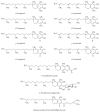Vitamin E Analogs as Radiation Response Modifiers
- PMID: 26366184
- PMCID: PMC4558447
- DOI: 10.1155/2015/741301
Vitamin E Analogs as Radiation Response Modifiers
Abstract
The potentially life-threatening effects of total body ionizing radiation exposure have been known for more than a century. Despite considerable advances in our understanding of the effects of radiation over the past six decades, efforts to identify effective radiation countermeasures for use in case of a radiological/nuclear emergency have been largely unsuccessful. Vitamin E is known to have antioxidant properties capable of scavenging free radicals, which have critical roles in radiation injuries. Tocopherols and tocotrienols, vitamin E analogs together known as tocols, have shown promise as radioprotectors. Although the pivotal mechanisms of action of tocols have long been thought to be their antioxidant properties and free radical scavenging activities, other alternative mechanisms have been proposed to drive their activity as radioprotectors. Here we provide a brief overview of the effects of ionizing radiation, the mechanistic mediators of radiation-induced damage, and the need for radiation countermeasures. We further outline the role for, efficacy of, and mechanisms of action of tocols as radioprotectors, and we compare and contrast their efficacy and mode of action with that of another well-studied chemical radioprotector, amifostine.
Figures


Similar articles
-
Antioxidant Tocols as Radiation Countermeasures (Challenges to be Addressed to Use Tocols as Radiation Countermeasures in Humans).Antioxidants (Basel). 2018 Feb 23;7(2):33. doi: 10.3390/antiox7020033. Antioxidants (Basel). 2018. PMID: 29473853 Free PMC article. Review.
-
Vitamin E: tocopherols and tocotrienols as potential radiation countermeasures.J Radiat Res. 2013 Nov 1;54(6):973-88. doi: 10.1093/jrr/rrt048. Epub 2013 May 8. J Radiat Res. 2013. PMID: 23658414 Free PMC article. Review.
-
Radioprotectors - the evergreen topic.Chem Biodivers. 2013 Oct;10(10):1791-803. doi: 10.1002/cbdv.201300054. Chem Biodivers. 2013. PMID: 24130023 Review.
-
Synthetic and Natural Radioprotective Agents: Recent Status and their Underlying Mechanism of Action.Curr Pharm Biotechnol. 2025;26(5):700-715. doi: 10.2174/0113892010293722240522071042. Curr Pharm Biotechnol. 2025. PMID: 38818911 Review.
-
Radioprotection and Radiomitigation: From the Bench to Clinical Practice.Biomedicines. 2020 Oct 30;8(11):461. doi: 10.3390/biomedicines8110461. Biomedicines. 2020. PMID: 33142986 Free PMC article. Review.
Cited by
-
Tocotrienols Provide Radioprotection to Multiple Organ Systems through Complementary Mechanisms of Antioxidant and Signaling Effects.Antioxidants (Basel). 2023 Nov 9;12(11):1987. doi: 10.3390/antiox12111987. Antioxidants (Basel). 2023. PMID: 38001840 Free PMC article. Review.
-
Vitamins and nutrients as primary treatments in experimental brain injury: Clinical implications for nutraceutical therapies.Brain Res. 2016 Jun 1;1640(Pt A):114-129. doi: 10.1016/j.brainres.2015.12.030. Epub 2015 Dec 23. Brain Res. 2016. PMID: 26723564 Free PMC article. Review.
-
The Protective Effects of 5-Methoxytryptamine-α-lipoic Acid on Ionizing Radiation-Induced Hematopoietic Injury.Int J Mol Sci. 2016 Jun 14;17(6):935. doi: 10.3390/ijms17060935. Int J Mol Sci. 2016. PMID: 27314327 Free PMC article.
-
Promising role of filgrastim and α-tocopherol succinate in amelioration of gastrointestinal acute radiation syndrome (GI-ARS) in mice.Naunyn Schmiedebergs Arch Pharmacol. 2019 Dec;392(12):1537-1550. doi: 10.1007/s00210-019-01702-6. Epub 2019 Jul 27. Naunyn Schmiedebergs Arch Pharmacol. 2019. PMID: 31350581
-
Antioxidant Tocols as Radiation Countermeasures (Challenges to be Addressed to Use Tocols as Radiation Countermeasures in Humans).Antioxidants (Basel). 2018 Feb 23;7(2):33. doi: 10.3390/antiox7020033. Antioxidants (Basel). 2018. PMID: 29473853 Free PMC article. Review.
References
-
- Carter A. B., May M. M., Perry W. J. The day after: action following a nuclear blast in a U.S. city. Washington Quarterly. 2007;30(4):19–32. doi: 10.1162/wash.2007.30.4.19. - DOI
-
- Sovacool B. The Dirt on Nuclear Power. https://www.project-syndicate.org/commentary/the-dirt-on-nuclear-power.
Publication types
Grants and funding
LinkOut - more resources
Full Text Sources
Other Literature Sources
Miscellaneous

